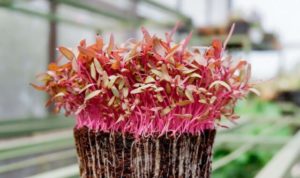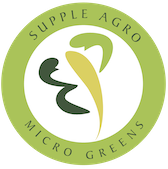No products in the cart.
Know About Microgreens | Types & Uses
What are microgreens?
It is quite simple to extract the meaning for the name itself, “microgreens” which means “the micro variants of matured plants”.
Microgreens are the budding stage of plants, it is the time when leaves merely start to grow and shoots are 2-3 inches tall. They can be grain, herb, or vegetables cultivated in a growing medium and harvested within a few weeks before developing the first plant of grown leaves.
In the year 1980 microgreens commenced showing up on menus and for the first time, they were seen formally seen in chefs’ menus at San Francisco.
Slowly and gradually the idea was accepted all over the world. And now microgreens are in one of the leading positions for organic lovers.
Hey, don’t get confused with sprouts, microgreens are entirely different!
So let’s move towards understanding different types of microgreens and see what they truly are.

Microgreens family!
There are many varieties that stand under the category of microgreens and the name may sound familiar to you which are Onion, Beetroot, Cabbage, Amaranth red, Radish White, Broccoli, Cauliflower, and a few others.
For the ease of understanding, we have categorized the varieties into different families.
- Asteraceae family: Endive, lettuce, chicory, and radicchio
- Brassicaceae family: Cauliflower, cabbage, broccoli, watercress, radish, and arugula
- Apiaceae family: Dill, fennel, carrot, and celery
- Amaranthaceae family: Amaranth, beet, quinoa swiss chard, and spinach
- Cucurbitaceae family: Melon, cucumber, and squash
- Amaryllidaceae family: Onion, garlic, leek
Microgreens are soo beneficial
You can not imagine how beneficial these little greens plants are to you. Easy to grow, completely pesticide-free, and can be consumed just after harvesting.
With all these benefits microgreens gives you a complete package of health & nutrition.
- High Nutrition: They are full of vitamins, minerals, potassium, iron, zinc, magnesium, and copper. The nutrients that are required by every age group.
Each microgreen has a different nutritional value and all of them are highly rich in fiber. Microgreens are at healthiest when consumed raw, so what could be a better way than consuming high nutrients at simply one go. - Cost-effective: They can be grown in a very cost-efficient way and are completely fuss-free to grow. So say goodbye to expensive ornamental plants and use these versatile options for garnishing.
- High nutrient than mature greens: Researches have confirmed that microgreens have higher nutrients (nine times higher) than mature plants.
Additionally researches also confirm that microgreens contain a wider variety of polyphenols and other antioxidants.
Microgreens have many eating options
As we already discussed, the nutrients of microgreens are high when eaten raw. However, every microgreen has a different story and a tasty way to be consumed.
You can have them as a salad or use them to garnish. You can also make a microgreens sandwich or smoothie.
Microgreens are wholesome and delicious in every way you eat them. So wherever you find them grab the opportunity to add to your own recipe.

Differences between microgreens & sprouts
So now as we know what are microgreens and their types, let us also explore the reason for how they differ from sprouts.
| Microgreens | Sprouts |
| Grown in soil | Germinate in water |
| Leaves & stem are eatable | Stem & seeds are eatable |
| Takes two-three weeks to grow, depending upon variety (approx) | Under a week to grow |
| Used mostly for garnishing | Used for crunch |
| Over 100 varieties | Just a few varieties are available |
| Higher nutrients especially fiber level | Lower nutrients and fiber level |
| Requires sunlight to grow | Do not need sunlight to grow |
Take away notes
The microgreens have always been a smarter and healthier choice of every organic lover, they are full of nutrients, and therefore adding them as a part of a meal boosts the health and immunity of every age group.
Microgreens are mostly confused by sprouts, but both of them have an entirely different science that we already discussed.
To sum it up, all I would say is, “no matter how or which microgreens you are consuming. Make a habit of adding them to your diet”.
And if you are worried about finding them fresh contact us – Microgreens.










